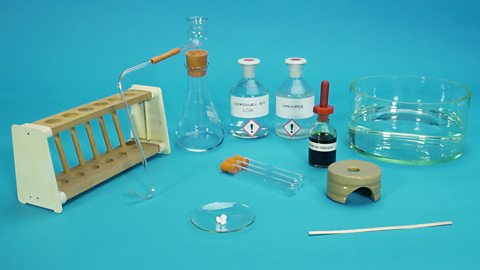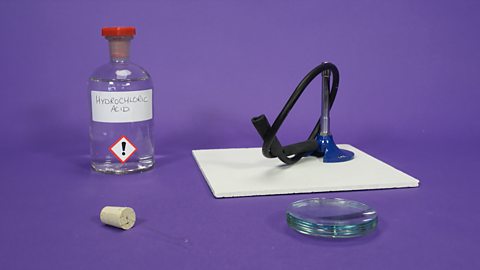What are the key learning points about prescribed practical C9?
Carbon dioxide gas can be prepared by the reaction of calcium carbonate with hydrochloric acid. The gas produced can be tested with limewater.
Hydrogen can be prepared by the reaction of zinc with hydrochloric acid. The gas produced can be tested with a lit splint.
Oxygen can be prepared by the decomposition reactionA chemical reaction where a compound breaks down into simpler substances. of hydrogen peroxide. The gas produced can be tested with a glowing splint.
What is the purpose of prescribed practical C9?
Three gases that are commonly produced in chemical reactions are hydrogen, oxygen and carbon dioxide.
In this investigation we will make a sample of each gas and use it to investigate the properties, tests and reactions of each gas.
In order to make each gas we need to have a method of collecting and storing the gas.
In the case of all gases we can use the displacement of water out of test-tubes or gas jars to collect the gas – this allows us to see when the test tube or gas jar is full.
For all experiments, follow the safety advice given by your teacher.
How is carbon dioxide gas prepared?
Carbon dioxide can be prepared by the reaction of calcium carbonate with hydrochloric acid:
calcium carbonate + hydrochloric acid → calcium chloride + carbon dioxide + water
The carbon dioxide produced can be collected by displacement of water out of a gas jar.
Preparing carbon dioxide gas.
What apparatus and chemicals are used to make carbon dioxide gas?

Conical flask with side arm, thistle funnel, delivery tube
3 gas jars with lids (or test tubes with stoppers)
Basin/trough of water
Test tube rack
Calcium carbonate small pieces 3 g
50 cm3 of hydrochloric acid 1 mol/dm3
Wooden splint
Limewater 5 cm3
Universal indicator solution
What are the steps involved in preparing carbon dioxide gas?
Carefully place the calcium carbonate into the conical flask.
Collect 50 cm3 of hydrochloric acid in a small beaker.
Connect the delivery tube and thistle funnel to the conical flask with the delivery tube in a basin of water.
Have three gas jars/test tubes filled with water also inverted in the basin of water.
Carefully pour the hydrochloric acid into the thistle funnel, wait 5 seconds then carefully place the first water filled gas jar/test tube over the end of the delivery tube. Allow the gas jar/test tube to fill with gas (when all of the water has been displaced).
Leave the gas jar/test tube inverted in the water to retain the gas.
Repeat step 5 until three gas jars/test tubes of gas have been collected.
Remove each gas jars/test tube from the water as required for the following tests.
How to test for carbon dioxide gas
To the first gas jar/test tube insert a lit splint – record your observations.
To the second gas jar/test tube add 1 cm3 of limewater, stopper and shake – record your observations.
To the third gas jar/test tube add 5 drops of universal indicator, stopper and shake – record your observations. Add a little deionised water if no change is observed and shake again.
The lit splint will go out.
The limewater will turn from colourless to cloudy/milky in the presence of carbon dioxide.
The universal indicator will turn red.
How is hydrogen gas prepared?
Hydrogen can be prepared by the reaction of zinc with hydrochloric acid:
zinc + hydrochloric acid → zinc chloride + hydrogen
The hydrogen produced can be collected by displacement of water out of a gas jar.
Preparing hydrogen gas
What apparatus and chemicals are used to make hydrogen gas?
Conical flask with side arm, thistle funnel, delivery tube
3 gas jars/test tubes and 3 stoppers
Basin/trough of water
Test tube rack
Basin/trough half-filled with water, bee hive shelf especially for gas jars
Zinc approx. 2.5 g
50 cm3 of hydrochloric acid 1 mol/dm3
Wooden splint
What are the steps involved in preparing hydrogen gas?
The same method is used as for carbon dioxide except zinc (or sometimes magnesium ribbon) is used in place of calcium carbonate.
Collect 3 gas jars/test tubes of hydrogen gas in the same way.
Carefully place the zinc (or magnesium) into the conical flask.
Collect 50 cm3 of hydrochloric acid in a small beaker.
Connect the delivery tube and thistle funnel to the conical flask with the delivery tube in a basin of water.
Have three gas jars/test tubes filled with water also inverted in the basin of water.
Carefully pour the hydrochloric acid into the thistle funnel, wait 5 seconds then carefully place the first water filled gas jar/test tube over the end of the delivery tube. Allow the gas jar/test tube to fill with gas (when all of the water has been displaced).
Leave the gas jar/test tube inverted in the water to retain the gas.
Repeat step 5 until three gas jars/test tubes of gas have been collected.
Remove each gas jar/test tube from the water as required for the following tests.
How to test for hydrogen gas
To the first gas jar/test tube insert a lit splint – record your observations.
You may need to repeat using a different gas jar/test tube of the gas.
In the presence of hydrogen, a lit splint produces a squeaky pop.
How is oxygen gas prepared?
Oxygen can be prepared by the decomposition reactionA chemical reaction where a compound breaks down into simpler substances. of hydrogen peroxide:
Hydrogen peroxide → water + oxygen
This reaction requires a manganese(IV) oxide catalyst A substance that speeds up a chemical reaction without being used up or chemically changed. It does this by providing an alternative reaction pathway with a lower activation energy..
The oxygen produced can be collected by displacement of water out of a gas jar.
Preparing oxygen gas.
What apparatus and chemicals are used to prepare oxygen gas?
Conical flask with side arm, thistle funnel, delivery tube
2 gas jars/test tubes and 2 stoppers
Basin/trough of water
Test tube rack
Basin/trough half-filled with water, beehive shelf (optional, but helps to stabilise test tubes)
Manganese dioxide/manganese(IV) oxide (3 g)
Hydrogen peroxide solution (20 vol)
Wooden splint
What are the steps involved in the preparation of oxygen gas?
Carefully place the manganese(IV) oxide into the conical flask.
Collect 50 cm3 of hydrogen peroxide solution in a small beaker.
Connect the delivery tube and thistle funnel to the conical flask with the delivery tube in a basin of water.
Have two test tubes filled with water also inverted in the basin of water.
Carefully pour the hydrogen peroxide solution into the thistle funnel, wait 5 seconds then carefully place the first water filled test-tube over the end of the delivery tube. Allow the test tube to fill with gas (when all of the water has been displaced).
Leave the test tube inverted in the water to retain the gas.
Repeat step 5 until two test tubes of gas have been collected.
Remove each test tube from the water as required for the following tests.
How to test for oxygen gas.
To the first test tube insert a glowing splint – record your observations.
Repeat with the second test tube of gas.
In the presence of oxygen, a glowing splint relights.
How much do you know about prescribed practical C9?
More on Unit 3: Prescribed practicals
Find out more by working through a topic
- count2 of 9

- count4 of 9
